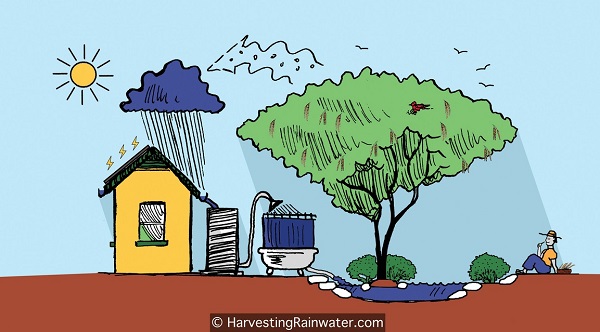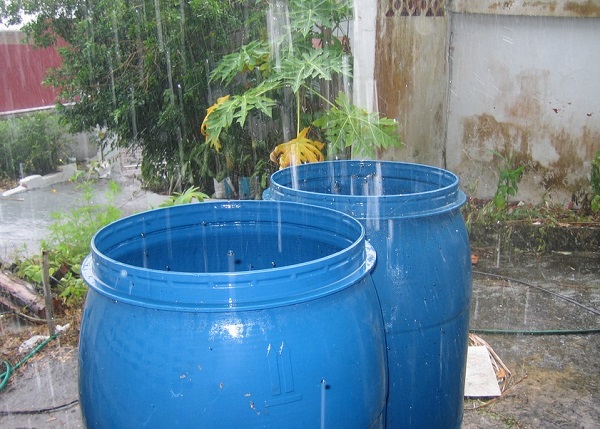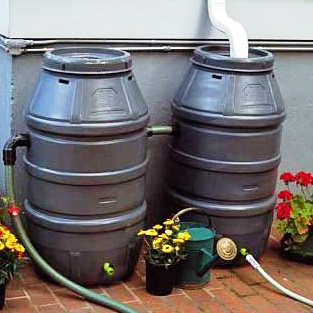
Storing water almost always ends up at the top of a prepper’s checklist of essentials during SHTF situations, and understandably so as it is the most important aspect of a person’s survival.
Having water in your body could spell the difference between life and death. Always remember that a person can last only three days, on the average, without water. This is why when confronted with TEOTWAYKI scenarios, it’s always important to have an ample supply of water that you can use for both domestic and outdoor purposes.
One way to store water is rainwater harvesting—the process of collecting rainfall, storing and (filtering
to some, especially when used for drinking), and distributing this for indoor or outdoor use.
Why harvest?
Setting up a rainwater catchment system at home can be tedious but just keep in mind that its benefits far outweigh the complex process involved to put it in place.

Aside from taking care of your needs during SHTF situations, harvesting rainwater can also:
- Reduce our reliance on dams, thus lessening the need to build new ones
- Lower water bills
- Reduce flooding and soil erosion
- Be used in irrigation as it doesn’t have chemicals that are found in groundwater, and
There are disadvantages to harvesting rainwater, but these could be minimized if your catchment system is built according to standards and by qualified individuals.
These include unpredictable rainfall; high cost involved during the initial stages of construction; quality of storage, which could affect the quality of water being stored; and need for regular maintenance.
What you should remember
If you’ve finally decided to harvest rainwater, there are several ways of doing it. Consider the following when deciding to resort to rainwater harvesting as part of your TEOTWAYKI preparations:
- Location of tanks/barrels (consider proximity to the house)
- Use for the water
- Storage material
- Number of persons in the household
- Materials used must be suitable for rainwater collection
- Gutters won’ t become breeding grounds for mosquitoes and bacteria, and have mesh nets to prevent leaves and other debris from blocking these
- Install first flush devices to avoid contaminated water from getting into your tank
- System must be well-maintained

The list is quite long but you don’t want to take chances when it comes to ensuring your family’s safety.
Setting up the system
Here are some of the materials you’ll need to put your water catchment system in place:
- Food-grade watertight barrel (number will depend on how much water you intend to store)
- Screen to filter water, prevent leaves and other debris from getting into the tank
- Spigot with pipe threads
- Overflow fitting and hose
- Pipe thread with adapter
- Lock nut
- Nipple to connect bulkhead fitting to shut-off valve
- Shut-off valve
- Hose union gasket
- Metal washers
- Teflon thread tape
- Silicon caulk
- S-shaped aluminium downspout elbow
- Concrete blocks
Clear the area next to your downspout (preferably the one closest to your garden) of debris and flatten it so rainwater will flow directly into the barrel. Dig a deep rectangle so you can place the barrels then place pea gravel in it. On top of the pea gravel, place the concrete blocks. Make sure it is wide enough to hold your barrel in place so the water stored won’t spill.
Drill a hole in the barrel to fit the spigot in. Make sure it is high enough to fit a bucket in. Put the spigot in place then attach the coupling from the inside. Tighten the seal by wrapping the threaded ends with Teflon tape.
If you intend to fill more than one water barrel, repeat the preceding procedure for the second barrel before drilling another hole near the topmost part for the overflow valve. Attach a garden hose directly to the valves so water can flow from your first barrel into the other.
Connect the elbow to the downspout then cut the area in the lid where water is supposed to flow into the barrel. Seal the downspout and elbow together tightly. Place a filter over the mouth of the downspout (the one near the roof gutter) and on the lid of the barrel to prevent leaves and debris from contaminating your stored water.

Simple harvesting systems are quick and easy to do. If you feel you need a more complex one and would prefer to also harvest water that could be used for drinking, there are professional rainwater tank installers, like http://www.rainwatertanksdirect.com.au/support/installation.php, that can help you with what you need.
For more information, check out this homeowner’s guide to rainwater harvesting.
Author Bio
Ava Hentze advocates rainwater harvesting as an answer to water shortage and flooding, as well as hair tangles. She’s learned to from experience that rain leaves the hair softer than conditioner. Her pet peeves: wastage and wasteful living.
Leave a Reply